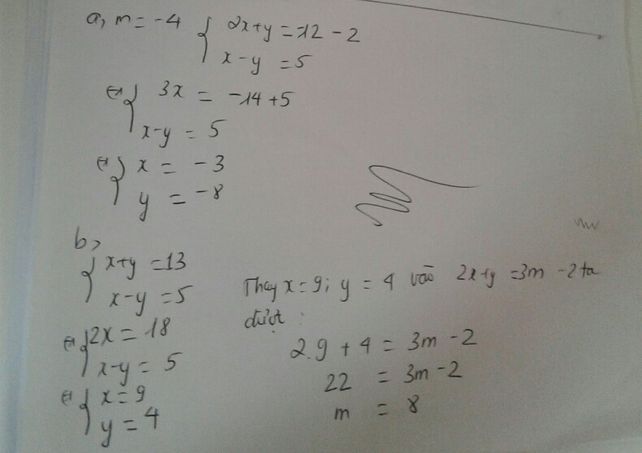Giải phương trình: \(x^y=y^x\).

Những câu hỏi liên quan
Giải phương trình nghiệm nguyên 1/x + 1/y = 1/2
Giải phương trình x^2+1/x^2 ++ 1/y^2 + y^2 = 4
\(\Leftrightarrow\frac{y+x}{xy}=\frac{1}{2}\)
=>\(\frac{x+y}{xy}-\frac{1}{2}=0\)
\(\Rightarrow\frac{-\left(x-2\right)y-2x}{2xy}=0\)
=>(x-2)y-2x=0
=>x-2=0( vì x-2=0 thì nhân y-2x ms =0 )
=>x=2
=>y-2=0
=>y=2
vậy x=y=2
Đúng 0
Bình luận (0)
giải hệ phương trình \(\left\{{}\begin{matrix}mx+2y=m+1\\x-y=2\end{matrix}\right.\)
a, giải hệ phương trình khi m=2
b, tìm m để hệ phương trình có nghiệm duy nhất (x,y) thỏa mãn xy = x+y+2
`x-y=2<=>x=y+2` thay vào trên
`=>m(y+2)+2y=m+1`
`<=>y(m+2)=m+1-2m`
`<=>y(m+2)=1-2m`
Để hpt có nghiệm duy nhất
`=>m+2 ne 0<=>m ne -2`
`=>y=(1-2m)/(m+2)`
`=>x=y+2=5/(m+2)`
`xy=x+y+2`
`<=>(5-10m)/(m+2)=(6-2m)/(m+2)+2`
`<=>(5-10m)/(m+2)=10/(m+2)`
`<=>5-10m=10`
`<=>10m=-5`
`<=>m=-1/2(tm)`
Vậy `m=-1/2` thì HPT có nghiệm duy nhât `xy=x+y+2`
Đúng 1
Bình luận (0)
`a)m=2`
$\begin{cases}2x+2y=3\\x-y=2\end{cases}$
`<=>` $\begin{cases}2x+2y=3\\2x-2y=4\end{cases}$
`<=>` $\begin{cases}4y=-1\\x=y+2\end{cases}$
`<=>` $\begin{cases}y=-\dfrac14\\y=\dfrac74\end{cases}$
Vậy m=2 thì `(x,y)=(7/4,-1/4)`
Đúng 0
Bình luận (0)
Sửa đoạn `xy=x+y+2`
``<=>(5-10m)/(m+2)^2=(6-2m)/(m+2)+2`
`<=>(5-10m)/(m+2)^2=10/(m+2)`
`<=>5-10m=10(m+2)`
`<=>1-2m=2m+4`
`<=>4m=-3`
`<=>m=-3/4(tm)`
Đúng 0
Bình luận (0)
1) Giải hệ phương trình $\left\{\begin{array}{l}2 x+y=19 \\ 3 x-2 y=11\end{array}\right.$.
2) Giải phương trình $x^{2}+20 x-21=0$.
3) Giải phương trình $x^{4}-20 x^{2}+64=0$.
3(2x+y)-2(3x-2y)=3.19-11.2
6x+3y-6x+4y=57-22
7y=35
y=5
thay vào :
2x+y=19
2x+5=19
2x=14
x=7
2/ x2+21x-1x-21=0
x(x+21)-1(x+21)=0
(x+21)(x-1)=0
TH1 x+21=0
x=-21
TH2 x-1=0
x=1
vậy x = {-21} ; {1}
3/ x4-16x2-4x2+64=0
x2(x2-16)-4(x2-16)=0
(x2-16)-(x2-4)=0
TH1 x2-16=0
x2=16
<=>x=4;-4
TH2 x2-4=0
x2=4
x=2;-2
Bài 1 :
\(\hept{\begin{cases}2x+y=19\\3x-2y=11\end{cases}\Leftrightarrow\hept{\begin{cases}4x+2y=38\\3x-2y=11\end{cases}\Leftrightarrow\hept{\begin{cases}7x=49\\2x+y=19\end{cases}}}}\)
\(\Leftrightarrow\hept{\begin{cases}x=7\\2x+y=19\end{cases}}\)Thay vào x = 7 vào pt 2 ta được :
\(14+y=19\Leftrightarrow y=5\)Vậy hệ pt có một nghiệm ( x ; y ) = ( 7 ; 5 )
Bài 2 :
\(x^2+20x-21=0\)
\(\Delta=400-4\left(-21\right)=400+84=484\)
\(x_1=\frac{-20-22}{2}=-24;x_2=\frac{-20+22}{2}=1\)
Bài 3 : Đặt \(x^2=t\left(t\ge0\right)\)
\(t^2-20t+64=0\)
\(\Delta=400+4.64=656\)
\(t_1=\frac{20+4\sqrt{41}}{2}\left(tm\right);t_2=\frac{20-4\sqrt{41}}{2}\left(ktm\right)\)
Theo cách đặt : \(x^2=\frac{20+4\sqrt{41}}{2}\Rightarrow x=\sqrt{\frac{20+4\sqrt{41}}{2}}=\frac{\sqrt{20\sqrt{2}+4\sqrt{82}}}{2}\)
\(\hept{\begin{cases}2x+y=19\\3x-2y=11\end{cases}\hept{\begin{cases}6x+3y=57\\6x-4y=22\end{cases}\hept{\begin{cases}7y=35\\3x-2y=11\end{cases}}}}\)
\(\hept{\begin{cases}y=5\\3x-2.5=11\end{cases}\hept{\begin{cases}y=5\\3x=21\end{cases}\hept{\begin{cases}y=5\\x=7\end{cases}}}}\)
\(a=1,b=20;c=-21\)
\(\Delta=\left(20\right)^2-\left(4.1.-21\right)=484\)
\(\sqrt{\Delta}=\sqrt{484}=22\)
\(x_1=\frac{-b+\sqrt{\Delta}}{2a}=\frac{-20+22}{2}=1\left(TM\right)\)
\(x_2=\frac{-b-\sqrt{\Delta}}{2a}=-21\left(TM\right)\)
\(3,x^4-20x^2+64=0\)
đặt \(x^2=a\)ta có pt
\(a^2-20a+64=0\)
\(a=1;b=-20;c=64\)
\(\Delta=\left(-20\right)^2-\left(4.1.64\right)=144\)
\(\sqrt{\Delta}=12\)
\(a_1=\frac{-b+\sqrt{\Delta}}{2a}=16\left(TM\right)\)
\(a_2=\frac{-b-\sqrt{\Delta}}{2a}=4\left(TM\right)\)
\(< =>x_1=\sqrt{16}=4\left(TM\right)\)
\(x_2=\sqrt{4}=2\left(TM\right)\)
vậy bộ n0 của pt là (\(4;2\))
Xem thêm câu trả lời
a, giải phương trình : 4x²+√2x+3=8x+1
B, giải hệ phương trình :
{√x+y+1+(x+2y)=4(x+y) ²+√3*√x+y
X-4y-3=(2y)²-√2-x²
tính đạo hàm
a) \(y=\dfrac{\left(x-2\right)^2}{\left(2x-3\right)\left(x-1\right)}\)
b) \(y=x+3+\dfrac{4}{x+3}\) giải phương trình y'=0
c) \(y=\dfrac{\left(5x-1\right)\left(x+1\right)}{x+2}\) tính y'(-1)
d) \(y=x-2+\dfrac{9}{x-2}\) giải phương trình y'=0
a:
ĐKXĐ: \(x\notin\left\{\dfrac{3}{2};1\right\}\)
\(y=\dfrac{\left(x-2\right)^2}{\left(2x-3\right)\left(x-1\right)}=\dfrac{x^2-4x+4}{2x^2-2x-3x+3}\)
=>\(y=\dfrac{x^2-4x+4}{2x^2-5x+3}\)
=>\(y'=\dfrac{\left(x^2-4x+4\right)'\left(2x^2-5x+3\right)-\left(x^2-4x+4\right)\left(2x^2-5x+3\right)'}{\left(2x^2-5x+3\right)^2}\)
=>\(y'=\dfrac{\left(2x-4\right)\left(2x^2-5x+3\right)-\left(2x-5\right)\left(x^2-4x+4\right)}{\left(2x^2-5x+3\right)^2}\)
=>\(y'=\dfrac{4x^3-10x^2+6x-8x^2+20x-12-2x^3+8x^2-8x+5x^2-20x+20}{\left(2x^2-5x+3\right)^2}\)
=>\(y'=\dfrac{2x^3-5x^2-2x+8}{\left(2x^2-5x+3\right)^2}\)
b:
ĐKXĐ: x<>-3
\(y=\left(x+3\right)+\dfrac{4}{x+3}\)
=>\(y'=\left(x+3+\dfrac{4}{x+3}\right)'=1+\left(\dfrac{4}{x+3}\right)'\)
\(=1+\dfrac{4'\left(x+3\right)-4\left(x+3\right)'}{\left(x+3\right)^2}\)
=>\(y'=1+\dfrac{-4}{\left(x+3\right)^2}=\dfrac{\left(x+3\right)^2-4}{\left(x+3\right)^2}\)
y'=0
=>\(\left(x+3\right)^2-4=0\)
=>\(\left(x+3+2\right)\left(x+3-2\right)=0\)
=>(x+5)(x+1)=0
=>x=-5 hoặc x=-1
c:
ĐKXĐ: x<>-2
\(y=\dfrac{\left(5x-1\right)\left(x+1\right)}{x+2}\)
=>\(y=\dfrac{5x^2+5x-x-1}{x+2}=\dfrac{5x^2+4x-1}{x+2}\)
=>\(y'=\dfrac{\left(5x^2+4x-1\right)'\left(x+2\right)-\left(5x^2+4x-1\right)\left(x+2\right)'}{\left(x+2\right)^2}\)
=>\(y'=\dfrac{\left(5x+4\right)\left(x+2\right)-\left(5x^2+4x-1\right)}{\left(x+2\right)^2}\)
=>\(y'=\dfrac{5x^2+10x+4x+8-5x^2-4x+1}{\left(x+2\right)^2}\)
=>\(y'=\dfrac{10x+9}{\left(x+2\right)^2}\)
\(y'\left(-1\right)=\dfrac{10\cdot\left(-1\right)+9}{\left(-1+2\right)^2}=\dfrac{-1}{1}=-1\)
d:
ĐKXĐ: x<>2
\(y=x-2+\dfrac{9}{x-2}\)
=>\(y'=\left(x-2+\dfrac{9}{x-2}\right)'=1+\left(\dfrac{9}{x-2}\right)'\)
\(=1+\dfrac{9'\left(x-2\right)-9\left(x-2\right)'}{\left(x-2\right)^2}\)
=>\(y'=1+\dfrac{-9}{\left(x-2\right)^2}=\dfrac{\left(x-2\right)^2-9}{\left(x-2\right)^2}\)
y'=0
=>\(\dfrac{\left(x-2\right)^2-9}{\left(x-2\right)^2}=0\)
=>\(\left(x-2\right)^2-9=0\)
=>(x-2-3)(x-2+3)=0
=>(x-5)(x+1)=0
=>x=5 hoặc x=-1
Đúng 1
Bình luận (0)
1. Giải phương trình: \(\sqrt{x-2}+\sqrt{4-x}=\sqrt{2}\) .
2. Giải phương trình: \(4x^4-7x^3+9x^2-10x+4=0\).
3. Giải hệ phương trình: \(\left\{{}\begin{matrix}x^2+y^2=3-xy\\x^4+y^4=2\end{matrix}\right.\) .
Bài 1: ĐKXĐ: $2\leq x\leq 4$
PT $\Leftrightarrow (\sqrt{x-2}+\sqrt{4-x})^2=2$
$\Leftrightarrow 2+2\sqrt{(x-2)(4-x)}=2$
$\Leftrightarrow (x-2)(4-x)=0$
$\Leftrightarrow x-2=0$ hoặc $4-x=0$
$\Leftrightarrow x=2$ hoặc $x=4$ (tm)
Đúng 2
Bình luận (0)
Bài 2:
PT $\Leftrightarrow 4x^3(x-1)-3x^2(x-1)+6x(x-1)-4(x-1)=0$
$\Leftrightarrow (x-1)(4x^3-3x^2+6x-4)=0$
$\Leftrightarrow x=1$ hoặc $4x^3-3x^2+6x-4=0$
Với $4x^3-3x^2+6x-4=0(*)$
Đặt $x=t+\frac{1}{4}$ thì pt $(*)$ trở thành:
$4t^3+\frac{21}{4}t-\frac{21}{8}=0$
Đặt $t=m-\frac{7}{16m}$ thì pt trở thành:
$4m^3-\frac{343}{1024m^3}-\frac{21}{8}=0$
$\Leftrightarrow 4096m^6-2688m^3-343=0$
Coi đây là pt bậc 2 ẩn $m^3$ và giải ta thu được \(m=\frac{\sqrt[3]{49}}{4}\) hoặc \(m=\frac{-\sqrt[3]{7}}{4}\)
Khi đó ta thu được \(x=\frac{1}{4}(1-\sqrt[3]{7}+\sqrt[3]{49})\)
Đúng 2
Bình luận (0)
Nãy mình tìm được một cách giải tương tự cho câu 2.
PT \(\Leftrightarrow\left(x-1\right)\left(4x^3-3x^2+6x-4\right)=0\)
\(\Leftrightarrow\left[{}\begin{matrix}x-1=0\\4x^3-3x^2+6x-4=0\left(1\right)\end{matrix}\right.\)
Vậy pt có 1 nghiệm bằng 1.
\(\left(1\right)\Rightarrow8x^3-6x^2+12x-8=0\)
\(\Leftrightarrow7x^3+x^3-6x^2+12x-8=0\)
\(\Leftrightarrow\left(x-2\right)^3=-7x^3\)
\(\Leftrightarrow x-2=-\sqrt[3]{7}x\)
\(\Leftrightarrow x=\dfrac{2}{1+\sqrt[3]{7}}\)
Vậy pt có nghiệm \(S=\left\{1;\dfrac{2}{1+\sqrt[3]{7}}\right\}\)
Lưu ý: Nghiệm của người kia hoàn toàn tương đồng với nghiệm của mình (\(\dfrac{2}{1+\sqrt[3]{7}}=\dfrac{1}{4}\left(1-\sqrt[3]{7}+\sqrt[3]{49}\right)\))
Đúng 0
Bình luận (0)
Xem thêm câu trả lời
Cho hệ phương trình: 2X +Y = 3m-2 ( m là tham số ) X - Y = 5 a) Giải hệ phương trình khi m = - 4 ; b) Tìm m để hệ phương trình có nghiệm (x; y) thỏa mãn: x + y = 13.
a) Giải bất phương trình:
\(\sqrt{x^2+2x}+\sqrt{x^2+3x}\) ≥ \(2x\)
b) Giải hệ phương trình
\(\left\{{}\begin{matrix}x^3+6x^2y+9xy^2+y^3=0\\\sqrt{x-y}+\sqrt{x+y}=2\end{matrix}\right.\)
a, ĐKXĐ : \(\left[{}\begin{matrix}x\le-3\\x\ge0\end{matrix}\right.\)
TH1 : \(x\le-3\) ( LĐ )
TH2 : \(x\ge0\)
BPT \(\Leftrightarrow x^2+2x+x^2+3x+2\sqrt{\left(x^2+2x\right)\left(x^2+3x\right)}\ge4x^2\)
\(\Leftrightarrow\sqrt{\left(x^2+2x\right)\left(x^2+3x\right)}\ge x^2-\dfrac{5}{2}x\)
\(\Leftrightarrow2\sqrt{\left(x+2\right)\left(x+3\right)}\ge2x-5\)
\(\Leftrightarrow\left[{}\begin{matrix}\left\{{}\begin{matrix}x< \dfrac{5}{2}\\x\ge-2\end{matrix}\right.\\\left\{{}\begin{matrix}x\ge\dfrac{5}{2}\\4x^2+20x+24\ge4x^2-20x+25\end{matrix}\right.\end{matrix}\right.\)
\(\Leftrightarrow\left[{}\begin{matrix}0\le x< \dfrac{5}{2}\\x\ge\dfrac{5}{2}\end{matrix}\right.\)
\(\Leftrightarrow x\ge0\)
Vậy \(S=R/\left(-3;0\right)\)
Đúng 1
Bình luận (0)
Cho hệ phương trình ( x+y = 2 mx−y = m với m là tham số.
a) Giải hệ phương trình khi m = −2.
b) Tìm giá trị của m để hệ phương trình có nghiệm duy nhất (x; y) sao cho 3x−y = −10.
c) Tìm giá trị nguyên của m để hệ phương trình có nghiệm (x; y) mà x, y là những số nguyên
a) Với m = -2
=> hpt trở thành: \(\left\{{}\begin{matrix}x+y=2\\-2x-y=-2\end{matrix}\right.\) <=> \(\left\{{}\begin{matrix}y=2-x\\-x=0\end{matrix}\right.\) <=> \(\left\{{}\begin{matrix}x=0\\y=2\end{matrix}\right.\)
Vậy S = {0; 2}
b) Ta có: \(\left\{{}\begin{matrix}x+y=2\left(1\right)\\mx-y=m\left(2\right)\end{matrix}\right.\)
=> x + mx = 2 + m
<=> x(m + 1) = 2 + m
Để hpt có nghiệm duy nhất <=> \(m\ne-1\)
<=> x = \(\dfrac{m+2}{m+1}\) thay vào pt (1)
=> y = \(2-\dfrac{m+2}{m+1}=\dfrac{2m+2-m-2}{m+1}=\dfrac{m}{m+1}\)
Mà 3x - y = -10
=> \(3\cdot\dfrac{m+2}{m+1}-\dfrac{m}{m+1}=-10\)
<=> \(\dfrac{2m+6}{m+1}=-10\) <=> m + 3 = -5(m + 1)
<=> 6m = -8
<=> m = -4/3
c) Để hpt có nghiệm <=> m \(\ne\)-1
Do x;y \(\in\) Z <=> \(\left\{{}\begin{matrix}\dfrac{m+2}{m+1}\in Z\\\dfrac{m}{m+1}\in Z\end{matrix}\right.\)
Ta có: \(x=\dfrac{m+2}{m+1}=1+\dfrac{1}{m+1}\)
Để x nguyên <=> 1 \(⋮\)m + 1
<=> m +1 \(\in\)Ư(1) = {1; -1}
<=> m \(\in\) {0; -2}
Thay vào y :
với m = 0 => y = \(\dfrac{0}{0+1}=0\)(tm)
m = -2 => y = \(\dfrac{-2}{-2+1}=2\)(tm)
Vậy ....
Đúng 1
Bình luận (0)



















 Bn tham khảo nhé!
Bn tham khảo nhé!






